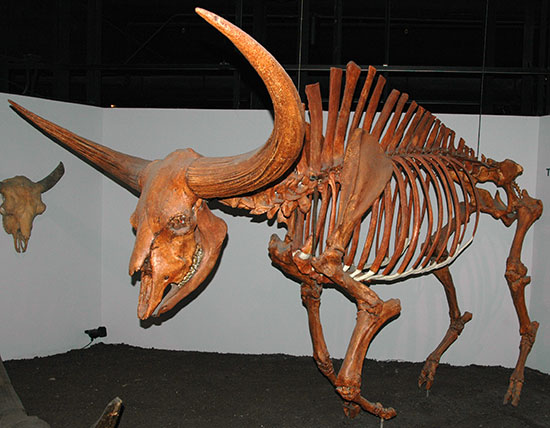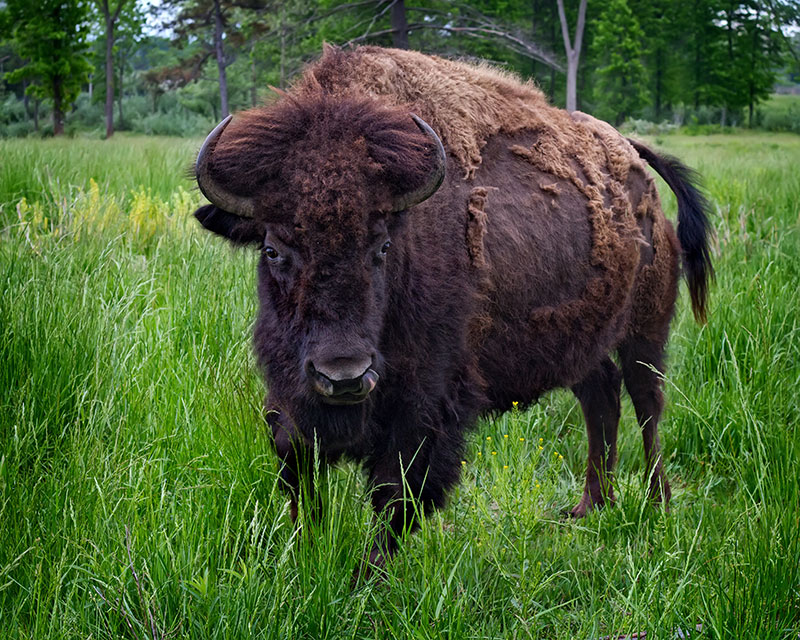Why to Skip a #bisonselfie + 9 More Bison Facts
Some people think bison are cute. But they are definitely not cuddly.
And you’re probably familiar with the fact that they used to roam the heartland in epic numbers – 50 million or so – until they were hunted nearly to extinction. But here’s a few more facts about bison that will blow you away.
1. They’re Not Just Big, but Nimble, Too
They can run up to 40 mph, jump six feet into the air from a standstill, and turn on a dime when threatened from behind, as if they were some sort of elephant-sized feline.
2. They’re Born To be Wild
While it’s hard to tame an animal of such size and physical ability, ultimately it’s the bison’s temperament that has prevented farmers from domesticating it. Many have tried, only to resign to the bison’s “wild and ungovernable temper.” There is even a saying about it: “You can herd a buffalo anywhere he wants to go.”
3. But Not As Wild As They Used to Be
Of the 500,000 bison alive in North America today, only about 15,000 are considered truly wild – the rest are in managed herds living within fenced ranges, whether for conservation purposes or meat production. Over time, hybridization with cattle have made bison slightly less bison-like. Only 1.6 percent of the population, about 8,000 animals, is free of cattle genes at this point, over half of which live in Yellowstone National Park.
4. Yet They Are Still Dangerous
Bison have horns up to two feet long, which they will use to throw a person into the air, off a cliff, or gore them to death, as if they were swatting a fly. Death by trampling is another easy option available when a bison feels threatened. Remember: if their tail is sticking straight up in the air, it means they are likely preparing to charge.
5. So, Bison Selfies Are a Bad Idea
Thirty-three people were injured by bison in Yellowstone National Park between 1983 and 1985, which led to new rules regarding the public’s interaction with these unpredictable beasts. Since then, injuries have dropped to an average of less than one per year in the park – until 2015, that is. Last year five people were charged by bison in a three-month period, mostly while having their picture taken just a few feet from the animal. Don’t do this:
Ok I promise, one last selfie. #bisonselfie #wheresthebeef #bc #supernatural
A photo posted by Kyle Z Melanson (@kylehimself1) on
When in Wyoming… #bisonselfie #wyoming #yellowstone #roadtrippin
A photo posted by t y l a m a n n (@tylajean) on
6. What’s With the Hump?
In winter, a bison’s head must function as a snowplow to seek out food – that burly-looking bulge on the back of their neck is composed of enormous muscles to power it.
7. And the Hairdo?
To survive outdoors in the winter, bison grow a thick coat, especially around their head. Their coat is so thick, in fact, that snow does not melt from their body heat, making them look like stoic ice monsters in the wintertime. Even in summer, males retain a thick mat of fur on their forehead as padding during the annual bouts of headbutting that occur as they vie for a mate. To that end, they also have special “bone struts” in their skull to prevent brain damage.
8. Did We Mention They’re Olympic-Caliber Swimmers?
Bison migrate vast distances as the seasons change, which means crossing big rivers. They are known to swim across rivers up to a mile wide, and navigate strong currents, even rapids, with ease. It helps that they are extremely buoyant, floating effortlessly with their head, hump, and rump above water.
9. And Boy, Can They Eat!
Bison are herbivores and must eat 1.6 percent of their body mass in grass (dry weight) each day. That’s about 32 pounds of vegetation for a one-ton bull. A bison that size will also drink about 30 gallons of water each day.
10. Let’s Not Forget Their Impressive Ancestors
Bison latifrons, also known as the broad-headed paleo-bison, or simply as the giant Ice Age bison, was about 25 to 50 percent larger than the modern bison when it came across the Bering land bridge that connected Asia and what is now Alaska roughly a quarter million years ago – making it possibly the largest ruminant ever walk the earth. With horns measuring nine feet from tip to tip, you’d think twice before taking a selfie with this creature.

Check out all our stories from #bisonweek!
Follow us

This work is licensed under a Creative Commons Attribution-NoDerivatives 4.0 International License.
Want to republish a Modern Farmer story?
We are happy for Modern Farmer stories to be shared, and encourage you to republish our articles for your audience. When doing so, we ask that you follow these guidelines:
Please credit us and our writers
For the author byline, please use “Author Name, Modern Farmer.” At the top of our stories, if on the web, please include this text and link: “This story was originally published by Modern Farmer.”
Please make sure to include a link back to either our home page or the article URL.
At the bottom of the story, please include the following text:
“Modern Farmer is a nonprofit initiative dedicated to raising awareness and catalyzing action at the intersection of food, agriculture, and society. Read more at <link>Modern Farmer</link>.”
Use our widget
We’d like to be able to track our stories, so we ask that if you republish our content, you do so using our widget (located on the left hand side of the article). The HTML code has a built-in tracker that tells us the data and domain where the story was published, as well as view counts.
Check the image requirements
It’s your responsibility to confirm you're licensed to republish images in our articles. Some images, such as those from commercial providers, don't allow their images to be republished without permission or payment. Copyright terms are generally listed in the image caption and attribution. You are welcome to omit our images or substitute with your own. Charts and interactive graphics follow the same rules.
Don’t change too much. Or, ask us first.
Articles must be republished in their entirety. It’s okay to change references to time (“today” to “yesterday”) or location (“Iowa City, IA” to “here”). But please keep everything else the same.
If you feel strongly that a more material edit needs to be made, get in touch with us at [email protected]. We’re happy to discuss it with the original author, but we must have prior approval for changes before publication.
Special cases
Extracts. You may run the first few lines or paragraphs of the article and then say: “Read the full article at Modern Farmer” with a link back to the original article.
Quotes. You may quote authors provided you include a link back to the article URL.
Translations. These require writer approval. To inquire about translation of a Modern Farmer article, contact us at [email protected]
Signed consent / copyright release forms. These are not required, provided you are following these guidelines.
Print. Articles can be republished in print under these same rules, with the exception that you do not need to include the links.
Tag us
When sharing the story on social media, please tag us using the following: - Twitter (@ModFarm) - Facebook (@ModernFarmerMedia) - Instagram (@modfarm)
Use our content respectfully
Modern Farmer is a nonprofit and as such we share our content for free and in good faith in order to reach new audiences. Respectfully,
No selling ads against our stories. It’s okay to put our stories on pages with ads.
Don’t republish our material wholesale, or automatically; you need to select stories to be republished individually.
You have no rights to sell, license, syndicate, or otherwise represent yourself as the authorized owner of our material to any third parties. This means that you cannot actively publish or submit our work for syndication to third party platforms or apps like Apple News or Google News. We understand that publishers cannot fully control when certain third parties automatically summarize or crawl content from publishers’ own sites.
Keep in touch
We want to hear from you if you love Modern Farmer content, have a collaboration idea, or anything else to share. As a nonprofit outlet, we work in service of our community and are always open to comments, feedback, and ideas. Contact us at [email protected].by Brian Barth, Modern Farmer
September 13, 2016
Modern Farmer Weekly
Solutions Hub
Innovations, ideas and inspiration. Actionable solutions for a resilient food system.
ExploreExplore other topics
Share With Us
We want to hear from Modern Farmer readers who have thoughtful commentary, actionable solutions, or helpful ideas to share.
SubmitNecessary cookies are absolutely essential for the website to function properly. This category only includes cookies that ensures basic functionalities and security features of the website. These cookies do not store any personal information.
Any cookies that may not be particularly necessary for the website to function and are used specifically to collect user personal data via analytics, ads, other embedded contents are termed as non-necessary cookies.
